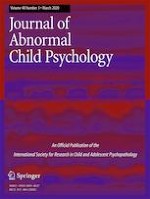12-12-2019
Self-Esteem Mediates Longitudinal Associations from Adolescent Perceptions of Parenting to Adjustment
Gepubliceerd in: Research on Child and Adolescent Psychopathology | Uitgave 3/2020
Log in om toegang te krijgenAbstract
The present study examines direct and indirect associations between perceptions of parenting and adolescent adjustment. We focus on self-esteem as an intervening variable. Participants included 446 girls and 471 boys ages 14 to 17 (M = 15.64) at the outset. A community sample of high school students was tracked for 3 consecutive years, completing annual surveys describing perceptions of parenting (i.e., psychological control and support), self-esteem, and adjustment (i.e., internalizing symptoms and externalizing symptoms). Longitudinal bidirectional associations emerged between adolescent perceptions of parenting (psychological control and support) and adolescent adjustment (externalizing and internalizing symptoms). Full longitudinal mediation analyses confirmed the hypothesized indirect links from perceived parenting to adolescent internalizing symptoms through adolescent self-esteem. High psychological control and low connectedness were associated with subsequent decreases in self-esteem, which, in turn, were associated with later increases in internalizing symptoms. Psychological control and connectedness also directly (but not indirectly) predicted changes in adolescent externalizing symptoms. Perceived psychological control and a lack of relatedness undercut self-confidence and undermine feelings of positive self-regard, which can eventually widen into more serious manifestations of psychological distress.
